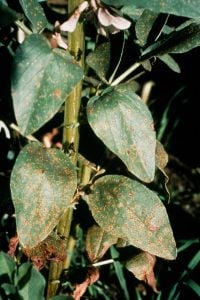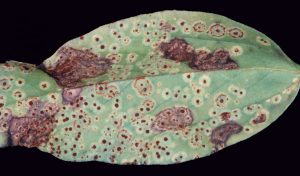Rust, caused by the pathogen Uromyces viciae-fabae, is a serious disease of faba beans in northern New South Wales and sporadically occurs in Victoria and South Australia. Rust epidemics can significantly reduce faba bean yields. Alone the disease has caused losses of up to 30 per cent, while, (in combination with chocolate spot), yield reductions of up to 50 per cent have been reported.
What to Look For
On the leaves there are numerous small, orange-brown pustules each surrounded by a light-yellow halo. As the disease develops, severely infected leaves wither and may fall from the plant.
On stems, the rust pustules are similar, but often larger, than those on the leaves. Isolated rust pustules may appear on the pods. Severe infection may cause premature defoliation, resulting in reduced seed size.

Infection by rust produces orange / brown pustules on leaves. Spores are easily dislodged by wiping with your finger.

Rust, Ascochyta and chocolate spot beans. Rust (left), ascochyta (centre) and chocolate spot (right)
Disease Cycle
The rust fungus survives on stubble and self-sown volunteer bean plants. The teliospores produced can infect volunteer bean plants directly without the need for an alternate host. Infection of volunteer faba bean plants is thought to be an important factor in the early development of rust epidemics. Rust spores from stubble and volunteers are blown onto new crops by the wind and infect plants. New spores form in rust pustules on infected plants. Secondary spread of the disease occurs when these spores become air-borne and then spread to other plants.
Rust commonly occurs late in the growing season during podding, resulting in premature leaf drop which can reduce seed weight and size. Humid and warm conditions (more than 20°C) promote disease spread.
Management
Because spores of the fungus can travel long distances to infect a new crop, prevention is difficult.
Paddock Selection
A break of at least three years between faba bean crops is recommended. Aim for a separation of 250m from the previous year’s faba bean paddock. Do not sow adjacent to last year’s faba bean stubble.
Variety Selection
A number of faba bean varieties are currently available with improved resistance to rust.
Chemical Control
Foliar fungicides can be used to control the disease and prevent a rust epidemic developing. Crops should be monitored closely if warm (approx 20°C) temperatures and very high humidity occur. Successful fungicide application relies on crop monitoring and timeliness of application with the right product effective against rust. Several products are registered for use against rust.




